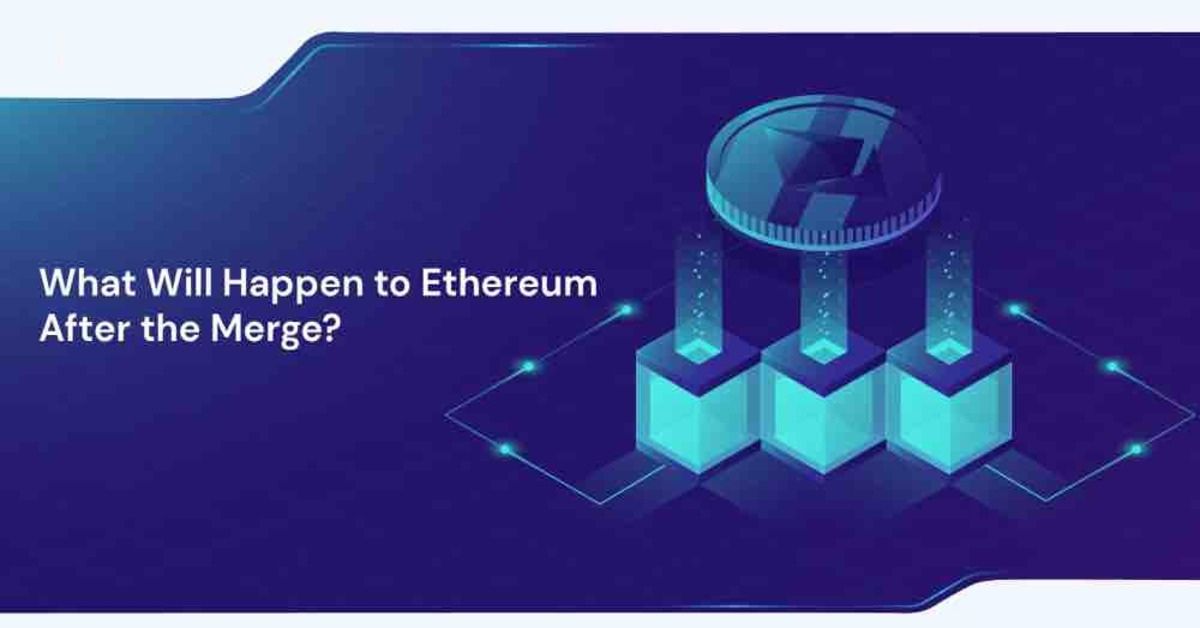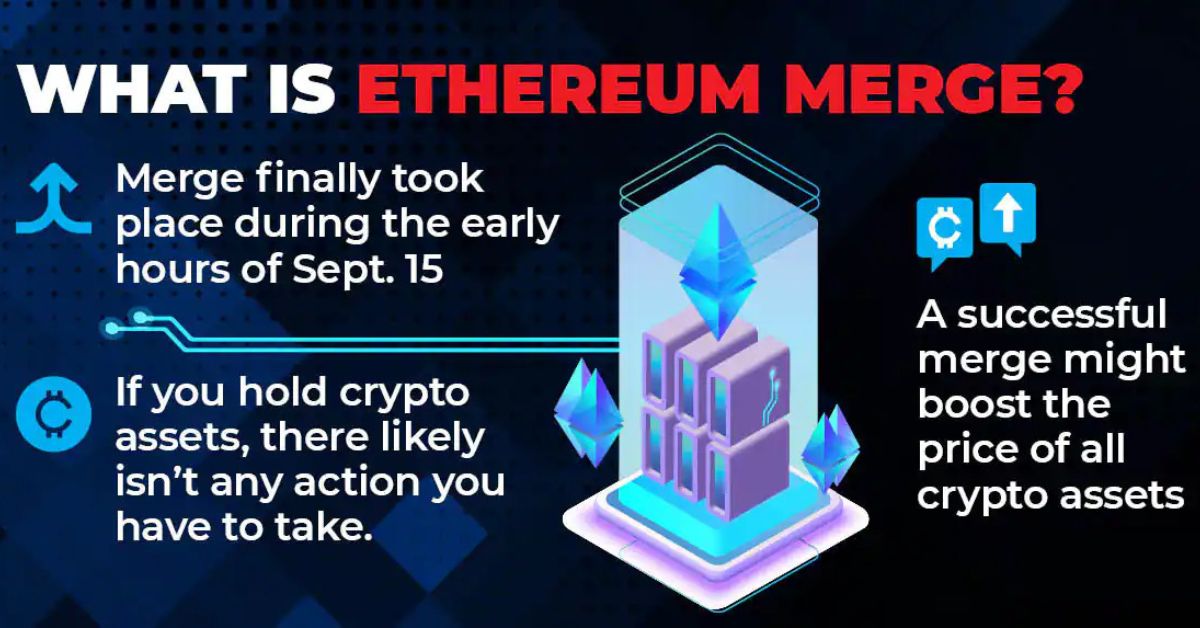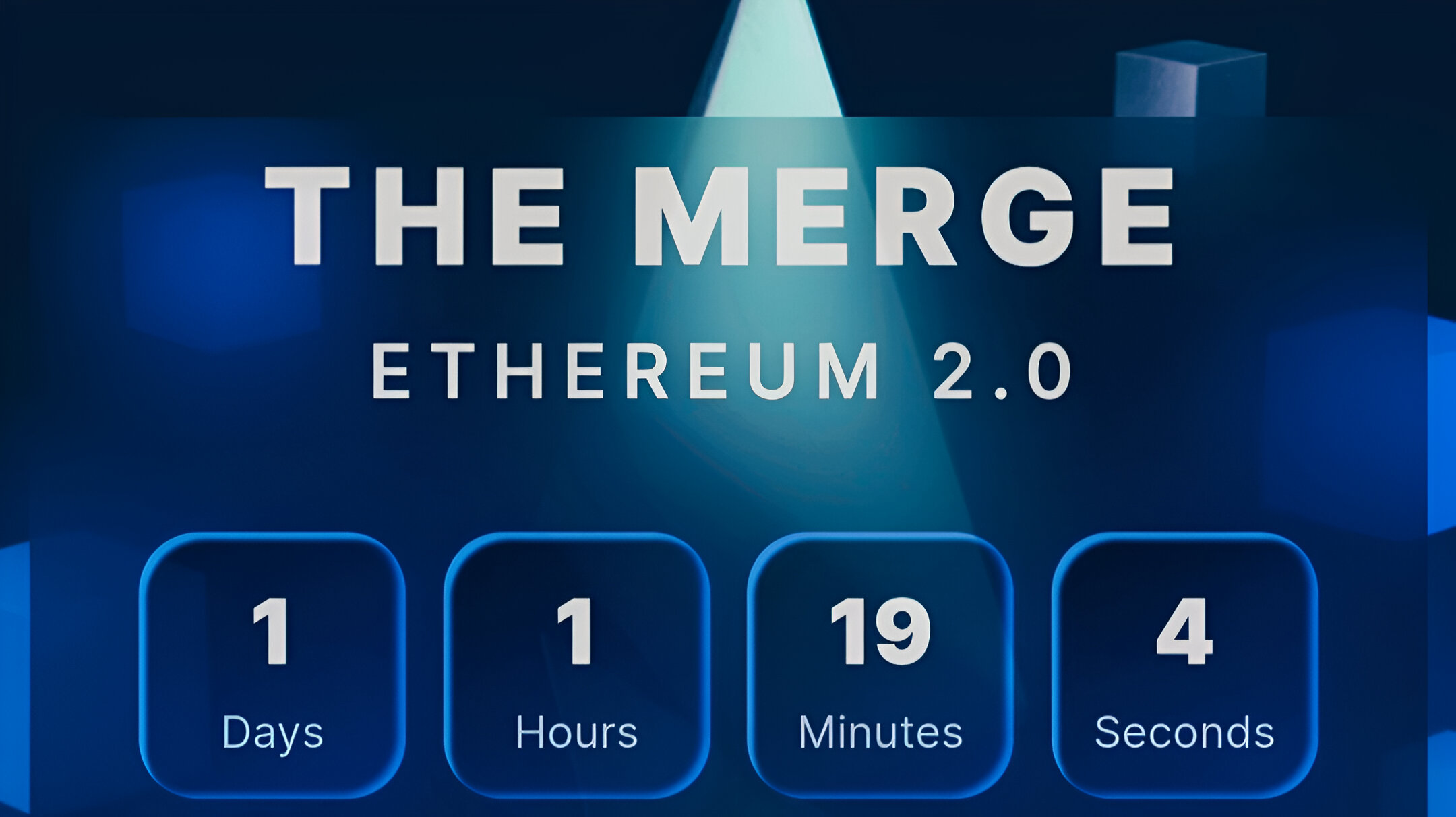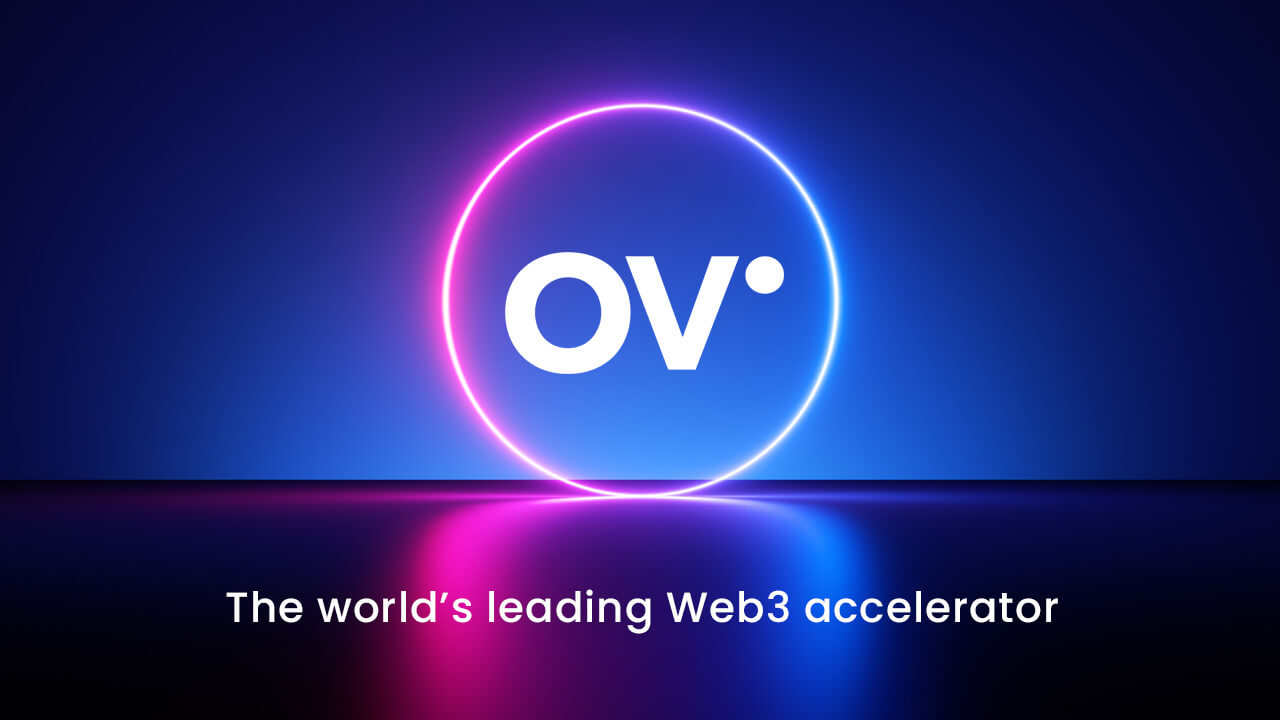Introduction
Ethereum, the world’s second-largest cryptocurrency by market capitalization, is on the cusp of a significant transformation. This transformation is known as Ethereum 2.0, which aims to address some of the limitations and challenges of the current Ethereum network. One crucial component of Ethereum 2.0 is the highly anticipated upgrade known as “the Merge.”
The Merge refers to the transition from Ethereum’s current consensus mechanism, Proof of Work (PoW), to Proof of Stake (PoS). This shift is expected to bring about numerous benefits for Ethereum and its community of users, developers, and stakeholders.
Proof of Stake operates on the principle that the selection of validators to create new blocks and validate transactions is done based on the number of coins they hold and are willing to “stake” or commit as collateral. In contrast, Proof of Work relies on miners performing computational puzzles to secure the network.
The Merge represents a fundamental shift in how Ethereum operates, marking a departure from the energy-intensive mining process to a more sustainable and efficient consensus mechanism. This upgrade has been eagerly anticipated for years, and its successful implementation will significantly shape the future of Ethereum and the wider blockchain ecosystem.
By transitioning to Proof of Stake, Ethereum aims to enhance its scalability, security, network efficiency, and overall sustainability. Additionally, the Merge will lay the foundation for Ethereum to support and enable a wide range of decentralized applications (dApps), decentralized finance (DeFi) platforms, and smart contracts at a much larger scale.
However, with such a major upgrade comes potential challenges and risks that need to be carefully assessed and mitigated. The transition process from Ethereum 1.0 to Ethereum 2.0 must be executed smoothly to ensure the integrity of the network and maintain users’ confidence in the platform.
In the following sections, we will explore the benefits of the Merge, the potential challenges it may face, and how it will impact Ethereum’s ecosystem as a whole. We will also delve into the technical advancements and improvements in scalability and security that Ethereum 2.0 aims to bring, as well as discuss the transition process from the current Ethereum network to the upgraded version.
Ethereum 2.0 and the Merge
Ethereum 2.0 is a major upgrade to the existing Ethereum network, aiming to overcome its limitations and propel the platform into a new era of scalability, efficiency, and sustainability. At its core, Ethereum 2.0 consists of two key components: the Merge and the Beacon Chain.
The Merge, also known as the “London hard fork,” involves the transition from Ethereum’s current Proof of Work (PoW) consensus mechanism to Proof of Stake (PoS). This shift is expected to alleviate many of the scalability issues that Ethereum currently faces, as well as reduce energy consumption and transaction fees.
With the Merge, Ethereum will no longer rely on miners to validate transactions and secure the network. Instead, Ethereum will implement a PoS consensus mechanism, where validators are selected based on the number of coins they hold and are willing to “stake” as collateral.
The Beacon Chain, on the other hand, serves as the backbone of Ethereum 2.0. It was launched in December 2020, acting as the primary PoS chain and facilitating the coordination of the Ethereum network’s various components.
By combining the Beacon Chain and the Merge, Ethereum is poised to become a more robust, scalable, and sustainable platform. The Merge will not only enhance Ethereum’s transaction throughput but also significantly reduce transaction fees, making it more accessible to users and developers alike.
Additionally, the Merge will pave the way for the integration of shard chains into Ethereum’s ecosystem. Shard chains divide the network into smaller pieces, enabling parallel processing of transactions and smart contracts. This will greatly enhance the platform’s scalability, allowing it to handle a significantly higher number of transactions simultaneously.
Furthermore, the Merge will foster the growth and development of decentralized applications (dApps) and decentralized finance (DeFi) platforms on the Ethereum network. With improved scalability and reduced transaction costs, Ethereum 2.0 will enable a wider range of use cases, attracting more developers and users to the platform.
It is important to note that the transition from Ethereum 1.0 to Ethereum 2.0 will not happen overnight. It will be a gradual process, carefully executed to ensure the stability and security of the network. The Ethereum community is actively working on the migration plan, which includes mechanisms to bridge the existing chain with the new PoS consensus mechanism.
In the next sections, we will explore the benefits and potential challenges of the Merge, its impact on Ethereum’s ecosystem, and the improvements in scalability and security that Ethereum 2.0 brings. We will also examine the transition process in more detail, highlighting the steps involved in upgrading the network and ensuring a seamless user experience.
Proof of Stake vs Proof of Work
The transition from Proof of Work (PoW) to Proof of Stake (PoS) is a key element of Ethereum 2.0 and the Merge. Understanding the differences between these two consensus mechanisms is crucial in appreciating the benefits that Ethereum 2.0 will bring.
Proof of Work, the current consensus mechanism used by Ethereum and other cryptocurrencies like Bitcoin, requires miners to solve complex mathematical puzzles to validate transactions and secure the network. This process consumes massive amounts of computational power, leading to high energy consumption and increasing concerns about environmental sustainability.
In contrast, Proof of Stake operates on a different principle. Instead of miners, validators are responsible for creating new blocks and validating transactions. Validators are chosen based on the number of coins they hold or are willing to “stake” as collateral.
One of the primary advantages of the PoS mechanism is its energy efficiency. Validators do not need to perform intensive calculations like miners in PoW networks, resulting in significantly lower energy consumption. This aspect is particularly important given the growing global focus on sustainable practices.
Another benefit of PoS is the reduced barrier to entry for participation in the consensus process. In PoW, miners need specialized hardware and extensive computational power to compete for block rewards. In PoS, any user with a minimum stake of cryptocurrency can become a validator, encouraging broader participation and decentralization of the network.
Additionally, PoS offers a higher level of security compared to PoW. With PoW, an attacker would need to control the majority of the network’s computing power to launch a successful attack. In PoS, an attacker would need to acquire the majority of the cryptocurrency supply, which is economically impractical.
One concern often raised about PoS is the potential for centralization. Critics argue that wealthier participants can accumulate more coins and gain a disproportionate influence over the network. However, Ethereum 2.0 incorporates measures to encourage decentralization and prevent excessive concentration of power, such as a cap on the maximum stake a validator can have.
Moreover, PoS encourages long-term commitment and stake holding. Validators who hold a significant stake in the network have a strong incentive to act honestly and maintain the integrity of the platform, as they risk losing their collateral in case of malicious behavior.
Overall, the transition from PoW to PoS in Ethereum 2.0 brings numerous benefits beyond energy efficiency. It promotes greater accessibility, security, and decentralization, making Ethereum a more inclusive, sustainable, and resilient platform for the future.
In the upcoming sections, we will delve into the specific benefits of the Merge, the potential challenges that may arise during the transition, and the broader impact of Ethereum 2.0 on the ecosystem.
Benefits of the Merge
The Merge, the transition from Ethereum’s current Proof of Work (PoW) consensus mechanism to Proof of Stake (PoS), brings forth a wide array of benefits for Ethereum and its community. This highly anticipated upgrade in Ethereum 2.0 promises to address many of the limitations of the current network and pave the way for a more scalable, efficient, and sustainable platform.
One of the key benefits of the Merge is improved scalability. Ethereum has faced challenges in handling a high volume of transactions, resulting in congestion and higher fees. The transition to PoS will enable Ethereum to process a larger number of transactions simultaneously, significantly easing network congestion and reducing transaction fees. This increased scalability will unlock opportunities for decentralized applications (dApps), decentralized finance (DeFi) platforms, and other use cases to flourish and reach a wider audience.
Another advantage lies in the energy efficiency of PoS. Unlike PoW, which relies on energy-intensive mining operations, PoS reduces energy consumption by eliminating the need for intensive computational puzzles. This shift aligns with growing environmental concerns and positions Ethereum as a more sustainable and eco-friendly blockchain platform.
Additionally, the Merge brings about enhanced security. With PoS, the risk of a successful 51% attack is significantly mitigated. Attackers would need to acquire a substantial portion of the overall cryptocurrency supply, which is economically impractical. This added security strengthens the integrity of the network and instills trust among users and developers.
The Merge also fosters decentralization. Unlike PoW, where mining operations are often centralized, PoS encourages broader participation in the consensus mechanism. Users with a minimum stake of cryptocurrency can become validators, fostering a more inclusive and decentralized network architecture. This distributed nature enhances the robustness and resilience of Ethereum.
Moreover, the reduced barriers to entry in PoS unlocks opportunities for wider community involvement. Individuals with smaller holdings of cryptocurrency can actively participate in consensus and earn rewards, promoting a more inclusive and democratized ecosystem.
The Merge will also streamline the development process for Ethereum. With the transition to PoS, the consensus mechanism becomes more predictable and deterministic, allowing for easier building and testing of new functionalities. This increased efficiency encourages innovation and accelerates the pace at which new features and improvements can be implemented on the Ethereum platform.
By bringing these benefits together, the Merge positions Ethereum as a leading blockchain platform capable of supporting a vast array of decentralized applications, enabling seamless global transactions, providing a secure and sustainable infrastructure for financial systems, and fueling the growth of the broader blockchain ecosystem.
In the following sections, we will explore the potential challenges and risks associated with the Merge, as well as the impact it will have on Ethereum’s ecosystem and the broader blockchain landscape.
Potential Challenges and Risks
While the transition from Ethereum’s current Proof of Work (PoW) consensus mechanism to Proof of Stake (PoS) brings numerous benefits, it is not without its challenges and risks. It is crucial to identify and address these potential issues to ensure the success and stability of the Ethereum network after the Merge.
One major challenge lies in the transition process itself. Moving from Ethereum 1.0 to Ethereum 2.0 requires the seamless integration of the existing chain with the new PoS consensus mechanism. This process must be carefully executed to ensure the smooth operation of the network, without causing disruptions or compromising the security of users’ funds and transactions.
In addition to technical challenges, there is also the social and economic aspect to consider. The Ethereum community needs to reach a consensus on the parameters of the transition and ensure that all stakeholders are onboard. This includes miners, developers, investors, and users who may have differing opinions on how the process should unfold. Building consensus and managing potential conflicts will be crucial for a successful transition.
Another potential risk is related to the economic incentives of validators. Validators play a crucial role in securing the network by selecting and validating transactions. However, there is a risk that some validators may act maliciously or not perform their tasks diligently. Validators have collateral at stake, but there is still a possibility of collusion or other forms of malicious behavior. Implementing mechanisms to prevent and mitigate such risks will be essential in maintaining the integrity and security of the Ethereum network.
Scalability is another area of concern. While the Merge is expected to improve Ethereum’s scalability, the network’s growth and increasing demand for decentralized applications and transactions could still pose challenges. Ensuring that the network can handle a growing number of participants and interactions will be crucial for maintaining a positive user experience and preventing congestion issues.
Furthermore, the transition to PoS may introduce new security vulnerabilities. While PoS is generally considered more secure than PoW, it is not immune to attacks. For example, a long-range attack could occur if an attacker gains control over a significant amount of stake accumulated in the past and attempts to rewrite the blockchain history. Implementing robust security measures and conducting thorough audits will be crucial in mitigating these risks.
Lastly, communication and transparency during the transition process will be vital for maintaining trust and confidence in the Ethereum ecosystem. Clear updates and consistent messaging about the progress, challenges, and changes throughout the transition will help users, developers, and stakeholders understand and adapt to the evolving Ethereum 2.0 network.
Despite these potential challenges and risks, the Ethereum community is actively working on addressing these issues. By leveraging the collective expertise and shared vision, Ethereum can navigate these obstacles and emerge as a more scalable, secure, and sustainable platform with Ethereum 2.0.
In the upcoming sections, we will explore the impact of the Merge on Ethereum’s ecosystem and discuss the improvements in scalability and security that Ethereum 2.0 brings.
Impact on Ethereum’s Ecosystem
The transition from Ethereum’s current Proof of Work (PoW) consensus mechanism to Proof of Stake (PoS) through the Merge will have a profound impact on Ethereum’s ecosystem. This upgrade to Ethereum 2.0 will bring about significant changes that extend beyond the underlying technology, touching various aspects of the platform and its users.
One of the notable impacts will be on transaction scalability. Ethereum has faced limitations in terms of transaction throughput, often leading to network congestion and high fees. The Merge will introduce improvements in scalability, enabling Ethereum to handle a significantly higher number of transactions per second. This increased capacity will not only enhance the user experience but also attract more developers and businesses to build applications and use cases on the Ethereum network.
Decentralized applications (dApps) and decentralized finance (DeFi) platforms will also see a transformational impact. The enhanced scalability and reduced transaction fees brought about by Ethereum 2.0 will enable dApps and DeFi platforms to scale and reach a broader user base. This scalability will support the growth of decentralized ecosystems, facilitating innovative financial tools, lending platforms, decentralized exchanges, and more.
Furthermore, the Merge will open new opportunities for users and developers alike. Individuals with smaller holdings of cryptocurrency will have the chance to participate in the consensus mechanism as validators. This accessibility promotes inclusivity and decentralization, empowering a broader spectrum of participants to actively engage with and contribute to the Ethereum ecosystem.
Another consequential aspect is the potential for new use cases and innovations. The enhanced scalability, improved security, and sustainability of Ethereum 2.0 will encourage developers to explore novel applications, pushing the boundaries of what is possible on the Ethereum network. The Merge will not only improve existing dApps but also foster the creation of new and more sophisticated applications, revolutionizing various industries, including finance, gaming, supply chain, and governance.
Ethereum’s merge to PoS will also have implications for mining. With the shift away from energy-intensive mining operations, miners will need to adapt and find alternative avenues within the Ethereum ecosystem. Some miners may transition to support other PoW networks, while others may explore staking or contribute their resources to different aspects of the crypto industry. This change may result in shifts in the distribution of network participants, further diversifying Ethereum’s ecosystem.
Overall, the impact of the Merge on Ethereum’s ecosystem will be far-reaching and transformative. It will bolster the growth of dApps and DeFi platforms, enable scalability for a larger number of users, and foster innovation and sustainability within the blockchain industry. The Ethereum community is poised to experience an accelerated pace of development, driven by the advancements made in Ethereum 2.0.
In the upcoming sections, we will discuss the technical improvements and advancements that Ethereum 2.0 brings, particularly in scalability and security.
Scalability and Performance Improvements
One of the main goals of Ethereum 2.0, specifically through the Merge, is to address the scalability challenges of the current Ethereum network. Ethereum 1.0, powered by Proof of Work (PoW), has struggled to handle the growing demand for transactions, resulting in network congestion and high fees. Ethereum 2.0 aims to overcome these limitations and provide significant scalability and performance improvements.
The transition from PoW to Proof of Stake (PoS) in the Merge will lay the foundation for improved scalability. By implementing PoS, Ethereum will be able to process a significantly higher number of transactions per second, offering a more efficient and responsive platform for users and developers. With PoS, validators are selected based on their stake, eliminating the need for energy-consuming mining operations and enabling parallel processing of transactions.
Furthermore, Ethereum 2.0 introduces the concept of shard chains. These shard chains divide the Ethereum network into smaller fragments, or shards, each capable of processing its own set of transactions and smart contracts. This parallelization allows for higher throughput and better distribution of the network’s workload. Sharding significantly improves Ethereum’s scalability, as it enables multiple transactions to be processed simultaneously across different shards, reducing congestion and enhancing the overall performance of the network.
With regards to transaction fees, Ethereum 2.0 aims to significantly reduce the cost of transactions. The scalability improvements provided by the Merge and the implementation of shard chains will alleviate network congestion, preventing transaction fees from skyrocketing during periods of high demand. Lower transaction fees enhance the accessibility of the Ethereum network, making it more viable for a broader range of applications, including microtransactions and everyday use cases.
Another performance improvement from the Merge is the reduced time required for block finality. In Ethereum’s current PoW mechanism, blocks are added to the blockchain when they are successfully mined, which can lead to temporary forks and the need for confirmations to ensure the validity of a transaction. In PoS, finality is achieved more quickly, ensuring that confirmed transactions cannot be reversed or altered, improving the overall efficiency of the network.
Ethereum 2.0’s scalability and performance improvements will not only benefit users and developers but also pave the way for the adoption of decentralized applications (dApps) at a larger scale. The increased transaction throughput, lower fees, and faster confirmation times will attract more projects and users to build and utilize dApps on the Ethereum network. This growth in dApp adoption, coupled with enhanced scalability, will foster innovation and further solidify Ethereum’s position as a leading blockchain platform.
In the upcoming sections, we will explore the enhanced security and sustainability that Ethereum 2.0 brings, as well as the transition from Ethereum 1.0 to the upgraded version.
Enhanced Security and Sustainability
The transition from Ethereum 1.0 to Ethereum 2.0 through the Merge brings about enhanced security and sustainability for the Ethereum network. These improvements are vital for ensuring the long-term viability and durability of the platform, as well as strengthening user confidence in Ethereum.
One of the key security enhancements in Ethereum 2.0 is the shift to Proof of Stake (PoS) consensus mechanism. In PoS, validators are chosen based on the number of coins they hold and are willing to “stake” as collateral. This mechanism significantly reduces the risk of a 51% attack, where an attacker gains control of the majority of the computational power on the network. Attackers in a PoS system would need to acquire a majority of the overall cryptocurrency supply, which is economically implausible.
Moreover, Ethereum 2.0 incorporates mechanisms to further enhance security, including slashing conditions and penalties for dishonest or malicious behavior by validators. Validators who act against the interests of the network may have their staked assets partially or fully confiscated, ensuring that they have a strong incentive to behave honestly and maintain the integrity of the platform.
Furthermore, the increased scalability brought about by Ethereum 2.0 has implications for security as well. By enabling parallel processing through the implementation of shard chains, Ethereum can distribute the workload across the network more efficiently, reducing the risk of congestion and reducing the potential for network attacks or disruptions.
Sustainability is another critical aspect addressed by Ethereum 2.0. The current Ethereum network, powered by Proof of Work (PoW), relies on energy-intensive mining operations that consume substantial amounts of electricity. This energy consumption has raised concerns about the environmental impact and long-term sustainability of the Ethereum network.
Through the transition to PoS, Ethereum 2.0 significantly reduces its energy consumption. Validators in PoS do not need to solve computationally intensive puzzles like miners in PoW, resulting in a more energy-efficient network. This shift aligns with the growing global focus on sustainability and positions Ethereum as a more environmentally friendly blockchain platform.
Reduced energy consumption not only addresses environmental concerns but also has implications for cost-effectiveness and accessibility. With lower energy requirements, validators in Ethereum 2.0 will not incur the substantial electricity costs associated with mining in Ethereum 1.0. This reduces the barrier to participation as a validator and allows individuals with smaller holdings to actively engage in securing the network, promoting greater decentralization and inclusivity.
Overall, the enhanced security and sustainability of Ethereum 2.0, facilitated by the transition to PoS, are crucial for the long-term success and durability of the Ethereum network. These improvements build trust and confidence among users, developers, and stakeholders, creating a solid foundation for continued innovation and growth within the Ethereum ecosystem.
In the following sections, we will delve into the transition process from Ethereum 1.0 to Ethereum 2.0 and discuss the steps involved in upgrading and maintaining the network.
Transition from Ethereum 1.0 to Ethereum 2.0
The transition from Ethereum 1.0 to Ethereum 2.0 is a complex process that involves careful planning and execution. It aims to seamlessly migrate the existing Ethereum network, powered by Proof of Work (PoW), to the upgraded Ethereum 2.0 network, based on Proof of Stake (PoS).
The transition process consists of several key steps designed to maintain network stability, security, and user confidence. One of the key components of the transition is the implementation of the Beacon Chain, which serves as the backbone of Ethereum 2.0. The Beacon Chain was launched in December 2020 to coordinate the network’s various components and facilitate the transition.
To kickstart the transition, the Beacon Chain runs in parallel with the existing Ethereum PoW network. This allows the Ethereum community to start staking ETH and participating in the new PoS consensus at an early stage. Validators can lock up a certain amount of ETH as collateral and participate in block validation. This simultaneous operation mitigates the risks associated with transitioning from PoW to PoS, ensuring a smooth and secure transfer of the network’s responsibilities.
Once the Beacon Chain is fully established and proven to be secure and reliable, the next phase is the Merge, also known as the London hard fork. The Merge involves combining the functionality of the existing Ethereum network with the Beacon Chain and transitioning from PoW to PoS. This process entails integrating the existing Ethereum chain with the new PoS consensus mechanism, effectively moving from mining to staking.
The Merge process requires careful coordination among developers, validators, and the wider Ethereum community. It involves complex technical considerations, such as developing consensus rules for the PoS system, ensuring compatibility between the existing Ethereum chain and the Beacon Chain, and implementing a secure and efficient migration process.
Throughout the transition, communication and transparency are crucial. The Ethereum community provides updates on the progress, challenges, and changes occurring during the upgrade. This ensures that users and developers are well-informed and can adapt to the evolving Ethereum 2.0 network.
While the transition is gradual, it is important to note that Ethereum 1.0 will eventually be fully merged into Ethereum 2.0. This means that the existing PoW network will be completely replaced by the PoS mechanism, offering enhanced scalability, security, and sustainability.
The transition from Ethereum 1.0 to Ethereum 2.0 signifies a monumental shift for Ethereum and the broader blockchain ecosystem. It represents the culmination of years of research and development, driven by the vision of creating a more scalable, secure, and sustainable platform.
In the next sections, we will explore further the technical advancements and improvements in scalability and security that Ethereum 2.0 brings, as well as the implications and potential future developments of the upgraded network.
Conclusion
The transition from Ethereum 1.0 to Ethereum 2.0, specifically through the Merge, marks a significant milestone for the Ethereum network and its community. This upgrade brings about numerous benefits, including improved scalability, enhanced security, increased sustainability, and expanded opportunities for users and developers.
The Merge represents a shift from Ethereum’s current Proof of Work (PoW) consensus mechanism to Proof of Stake (PoS). This transition enables Ethereum to handle a larger number of transactions per second and significantly reduces energy consumption, making the platform more efficient and environmentally friendly.
Scalability is a critical aspect addressed by Ethereum 2.0. Shard chains divide the network, allowing for parallel processing of transactions and smart contracts. This scalability enhancement opens up new possibilities for decentralized applications (dApps), decentralized finance (DeFi) platforms, and other blockchain-based use cases to thrive and reach a broader audience.
The Merge also improves the overall security of the Ethereum network. The PoS consensus mechanism mitigates the risk of 51% attacks and encourages decentralized participation, fostering a more secure and resilient ecosystem. Additionally, the increased predictability and faster block finality ensure the integrity of transactions and strengthen confidence in the Ethereum platform.
Ethereum 2.0’s sustainability measures make it an attractive choice in an increasingly environmentally conscious world. By transitioning to PoS and reducing energy consumption, Ethereum aligns with global sustainability goals while ensuring long-term viability and cost-effectiveness for its participants.
The transition process from Ethereum 1.0 to Ethereum 2.0 requires careful planning and execution. The integration of the Beacon Chain and the migration from PoW to PoS must be carried out smoothly to maintain network stability and user confidence. Effective communication and transparency within the Ethereum community are crucial throughout this transition to ensure a seamless upgrade process.
With Ethereum 2.0, the Ethereum ecosystem is poised for transformative growth and innovation. The enhanced scalability, improved security, and increased accessibility will support the development of a wide range of decentralized applications, financial systems, and blockchain-based solutions. Ethereum’s transition to a more sustainable and efficient platform sets the stage for broader adoption and positions Ethereum as a leading force in the blockchain industry.
As Ethereum continues to evolve and embrace the advantages of Ethereum 2.0, it will open up new opportunities, empower individuals, and revolutionize various sectors. The Ethereum community’s commitment to building a scalable, secure, and sustainable platform sets a strong foundation for a decentralized future.

























